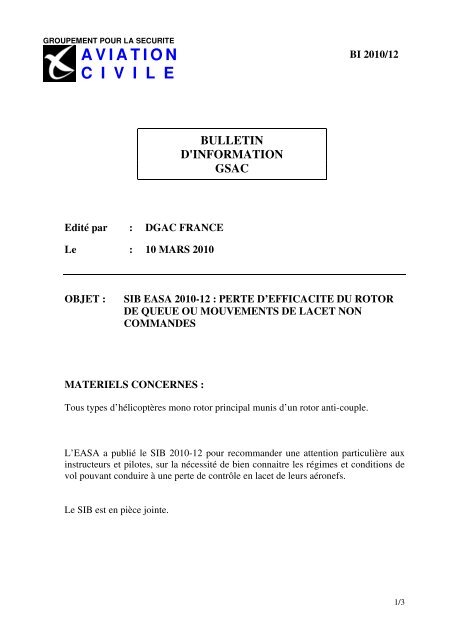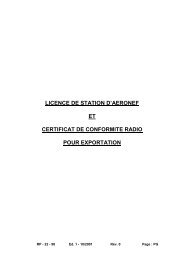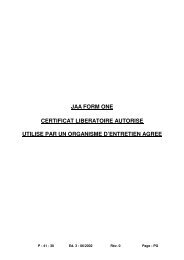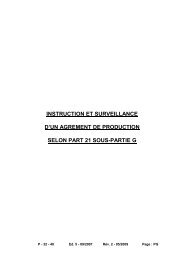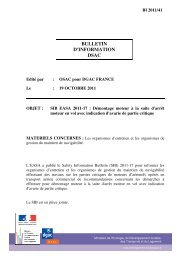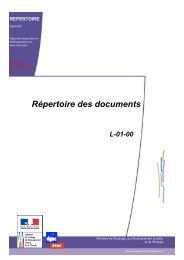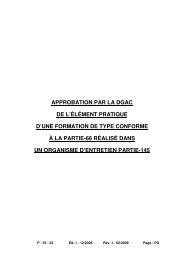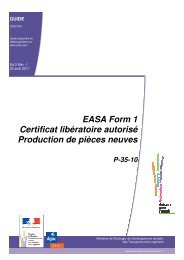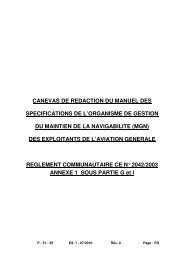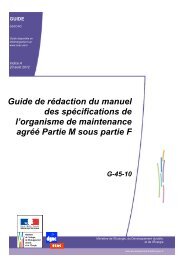AVIATION C I V I L E
AVIATION C I V I L E
AVIATION C I V I L E
You also want an ePaper? Increase the reach of your titles
YUMPU automatically turns print PDFs into web optimized ePapers that Google loves.
GROUPEMENT POUR LA SECURITEA V I A T I O N BI 2010/12C I V I L EBULLETIND'INFORMATIONGSACEdité par : DGAC FRANCELe : 10 MARS 2010OBJET :SIB EASA 2010-12 : PERTE D’EFFICACITE DU ROTORDE QUEUE OU MOUVEMENTS DE LACET NONCOMMANDESMATERIELS CONCERNES :Tous types d’hélicoptères mono rotor principal munis d’un rotor anti-couple.L’EASA a publié le SIB 2010-12 pour recommander une attention particulière auxinstructeurs et pilotes, sur la nécessité de bien connaitre les régimes et conditions devol pouvant conduire à une perte de contrôle en lacet de leurs aéronefs.Le SIB est en pièce jointe.1/3
EASA Safety Information BulletinSIB No.: 2010 - 12Issued: 24 February 2010Subject:Loss of tail rotor effectiveness (LTE) or unanticipatedyaw in helicoptersRef. Publication:[1] FAA-H-8083-21 Rotorcraft Flying Handbook.http://www.faa.gov/library/manuals/aircraft/media/faa-h-8083-21.pdf[2] FAA - AC No: 90-95 Unanticipated right Yaw in HelicoptersDate: 12/26/95.http://www.faa.gov/regulations_policies/advisory_circulars/index.cfm/go/document.information/documentID/23136[3] UK CAA - CAP 768 - Guidance Material for Operators, Chap21 - Miscellaneous Provisions Affecting helicopters Operations.http://www.caa.co.uk/docs/33/CAP%20768.pdfDescription:Loss of Tail rotor Effectiveness (LTE) has been determined to bea contributing factor in a number of accidents of various modelsof helicopters. Recently several helicopter reported accidents orincidents emphasize the phenomenon of loss of yaw control.LTE or unanticipated yaw results from lack of yaw marginencountered in certain flight conditions is not related to a failureor malfunction. LTE is a critical, low-speed aerodynamic flightcondition that could affect all single main rotor helicoptersequipped with a tail anti-torque device. The uncommanded yawoccurs to the right in helicopters with a counter clockwise rotatingmain rotor and to the left in helicopters with a clockwise rotatingmain rotor.The conditions under which LTE may be encountered and how itcan be prevented are detailed in [1] and [3]. Actions to preventthe onset of LTE and recommended recovery techniques are alsoexplained in [2].Recommendation:In order to understand the LTE phenomenon, theoretical and flighttraining of pilots should emphasise the characteristics and functionof the anti torque system. In particular, emphasis should beplaced on those flight regimes where combinations of variouselements (e.g. relative wind vector, yaw rate, etc.) could lead to apotential LTE situation. Pilots should be able to recognise thepossibility of experiencing LTE, its onset and be prepared torecover.This is information only. Recommendations are not mandatory.EASA Form 117 Page 1/22/3
EASA SIB No. 2010 - 12Pilots should be aware of the characteristics of the different modelsof helicopter flown and, in particular, the yaw pedal input typicallyrequired for different flight conditions.The theoretical and flight training should be conducted by approvedtraining organisations and instructors having appropriateexperience and knowledge of this phenomenon.The Agency further recommends to NAA’s to ensure that anyPPL(H), CPL(H), ATPL(H) and Flight Instructor training coursesinclude sufficient and dedicated training on LTE and recoveryactions.Applicability:All single main rotor helicopters equipped with a tail anti-torquedevice.Contact:For further information contact the Airworthiness Directives, SafetyManagement & Research Section, Certification Directorate, EASA.E-mail: ADs@easa.europa.euThis is information only. Recommendations are not mandatory.EASA Form 117 Page 2/23/3


